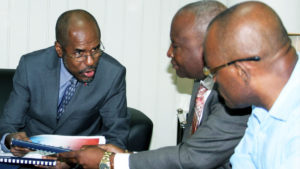

CARICOM
The Caribbean Community (CARICOM) is a grouping of twenty countries: fifteen Member States and five Associate Members. It is home to approximately sixteen million citizens, 60% of whom are under the age of 30, and from the main ethnic groups of Indigenous Peoples, Africans, Indians, Europeans, Chinese and Portuguese. The Community is multi-lingual; with English as the major language complemented by French and Dutch and variations of these, as well as African and Indian expressions.
CARICOM came into being on 4 July 1973 with the signing of the Treaty of Chaguaramas by Prime Ministers Errol Barrow for Barbados, Forbes Burnham for Guyana, Michael Manley for Jamaica and Eric Williams for Trinidad and Tobago. The Treaty of Chaguaramas established the Caribbean Community and Common Market replacing the Caribbean Free Trade Association which ceased to exist on 1 May 1974. The Treaty was later revised in 2002 to allow for the eventual establishment of a single market and a single economy, and become known as CARICOM (CSME).
CARICOM is one of the longest surviving integration movements among developing countries. The original Treaty of Chaguaramas was signed on 4 July 1973, in honour of the birthday of Norman Washington Manley, a leading advocate of the West Indies Federation and one of Jamaica’s national heroes. The Treaty and its Annex (setting out the details of the Common Market Arrangements) came into effect on 1 August 1973. Since 2001, the Community has been functioning within the framework of the Revised Treaty of Chaguaramas.
In addition to economic issues, the Community instrument addressed issues of foreign policy coordination and functional cooperation. Issues of economic integration, particularly those related to trade arrangements, were addressed in the CSME Annex.
CARICOM has made great strides, particularly through functional cooperation in education, in health, in culture, in security. It Single Market functions and it is a respected voice in international affairs.
Membres
| Pays | Date d’adhésion | Population | PIB (en milliard USD) | PIB PC |
| Antigua-et-Barbuda | July 4 1974 | 100,963 | 1.4 | 13,866.47 |
| Bahamas | July 4 1983 | 391,232 | 9.047 | 23,124.39 |
| La Barbade | August 1 1973 | 284,996 | 4.588 | 16,098.47 |
| Belize | May 1 1974 | 366,954 | 1.765 | 4,809.87 |
| Dominique | May 1 1974 | 73,543 | 0.5254 | 7,144.12 |
| Grenade | May 1 1974 | 107,317 | 1.016 | 9,467.28 |
| Guyane | August 1 1973 | 773,303 | 3.446 | 4,456.21 |
| Haïti | July 1 2002 | 10,847,334 | 8.023 | 739.63 |
| Jamaïque | August 1 1973 | 2,881,355 | 14.027 | 4,868.20 |
| Montserrat | May 1 1974 | 4,932 | 0.176 | 35,685.32 |
| Sainte-Lucie | May 1 1974 | 178,015 | 1.379 | 7,746.54 |
| St Kitts et Nevis | July 26 1974 | 54,821 | 0.917 | 16,727.17 |
| St Vincent et les Grenadines | May 1 1974 | 109,643 | 0.771 | 7,031.91 |
| Suriname | July 4 1995 | 558,368 | 3.621 | 6,484.97 |
| Trinité-et-Tobago | August 1 1973 | 1,364,962 | 20.989 | 15,376.98 |
| Membres Assocés | ||||
| Anguilla | July 4 1999 | 13,477 | 0.77 | 57,134.38 |
| Bermudes | July 2 2003 | 65,331 | 5.574 | 85,319.37 |
| Îles Vierges Britanniques | July 2 1991 | 30,661 | – | |
| Îles Caïmans | May 12 2002 | 60,765 | 3.207 | 52,777.09 |
| îles Turques-et-Caïques | July 2 1991 | 39,200 | 1.963 | 50,076.53 |

 130.85
130.85 











